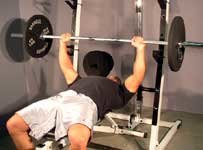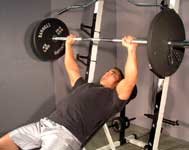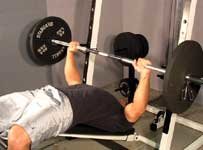If you are one of the many avid lifters who train on a regular basis, then you should be well aware that muscles require a "shock" in order for them to grow. You may have heard of the saying, "shocking your muscles" and if you have then you probably know what it means.
In order for your muscles to adapt, you have to shock it with different types of stimuli. Now there are probably a million and one ways to shock your muscles but I will discuss a few methods which I have used in the past and still use to some degree today.
Remember, shocking principles should be applied when you have hit a plateau. If you are just beginning to lift weights, then straight sets is all that your body will require. Now on to the goods.
1. Drop Sets
If you don't know what a drop set is, then I will explain. A drop set is when you start with X amount of weight and you perform as many reps as you can. When you reach failure, you strip off some of the weight and then perform another set to failure.
After reaching failure, you continue to strip off weight and pound out reps to the best of your ability. I have used drop sets for nearly all of my body parts and I must warn you that it hurts like you wouldn't believe.
First off, you need to have mental toughness if you want to finish a drop set. Second, it will burn and you will lose feeling in whatever muscle group you're working. Lastly, performing one drop set is enough to send any novice lifter crying home for help. So my advice to you is to try just one drop set to start out with and when you get comfortable enough, then add in a few more sets. Just don't overdo a good thing.
Some exercises that I have used drop sets for in the past include all:
- Bench presses
- Squats
- Leg extensions
- Leg curls
- Barbell curls
- Triceps extensions
- Dips
You can be creative in how you approach your drop set. Just make sure to be smart about it and don't forget to use a spotter.
2. Supersets
Supersetting is probably one of the most common shocking principles used throughout the gyms I have been in. When you perform a super set, you perform two exercises one right after the other with little rest in between.
For instance, you could perform incline dumbbell flyes followed by a set of incline bench press. Since this is also a pre-exhaust technique, the amount of weight you will be able to handle will be considerably less than if you started out fresh with the second exercise.
Make sure you use a spotter if you have never tried this technique before. Arnold was known for supersetting a lot of exercises. If you have ever seen his training program then you would know what I'm talking about. For instance, he would superset compound chest and back exercises.
You could do the same but once again, supersetting takes out a lot of energy from you and you need to start with a light volume. So if you're inexperienced with super setting, I would suggest that you try one super set to see how it feels.
Once you get accustomed to it, you can add one or two more super sets every so often. Some exercises which I would recommend supersetting are:
- Leg extensions and Lying leg curls
- Barbell curls and Weighted dips
- Dumbbell side laterals and Behind neck press
- Flyes and Bench presses
- Pull-overs and Barbell rows
- Leg extensions and Squats
- and various others...
Once again, be creative and stick with what works.
3. Giant Sets
Giant sets are similar to super sets with the exception that you perform three or more exercises back to back to back with little rest. I'm not a big fan of giant sets because by the time I get to my third exercise, I have very little left. One thing that I can recall doing in the past was performing flat bench press, incline bench press and decline bench press back to back to back.
I never knew 135 could be so heavy! To be honest with you, I don't know of many people who perform giant sets. If you do then do so at your own risk. You'll probably end up in the corner losing your lunch or whatever it is you had to eat. Just don't say that I didn't warn you.
4. Forced Reps
This is most definitely my favorite shocking principle! Why? Well, I have always used it since the days of training back at Berry College and it's worked wonders. Forced reps are exactly what they sound like. You force your muscles to work beyond their normal capacity. Let us use the bench press as an example. Let's say that you can only perform 225 lbs for 6 reps to positive failure.
Now if you apply forced reps, you could probably pound out 225 lbs for 8-10 reps. Now that you have handled 225 lbs for 8-10 reps, you are ready to go up in weight to say 235 lbs. At this point, you might be able to get 6-8 reps using the forced reps principle. If you keep up this progression, you may be able to perform 275 lbs for 6 reps using forced reps in a couple of months.
Now if you tried to bench press 225 lbs to positive failure, you would undoubtedly get at least 10 reps, if not more. This will lead to phenomenal gains since the muscle is being exerted to the max and beyond. The only drawback to forced reps is that it requires a spotter for almost all of your work sets otherwise it would not be possible.
Also, it is highly recommended that you use a spotter who knows what you're doing and knows how to spot. He/she needs to know how much help to apply to each rep so that the lifter can stay in the groove. Once the groove is broken, the lifting becomes much more difficult.
This technique is perhaps one of the more dangerous ones since you are handling a weight which you normally aren't used to and if the spotter's attention veers even for one moment, then you could face a weight crushing your skull. So be smart about your progression, get a good spotter and be ready to fight for your life on each rep.
Conclusion
These are some of the shocking principles which I have applied in the past and still use to this very day. They can benefit you and they can obviate your progress. Just learn what works for you because in essence, bodybuilding is a system that is built on trial and error. If something works extremely well for you, there is no need to change it until it stops working. If you have any questions, e-mail them to me at psom@yahoo.com.




